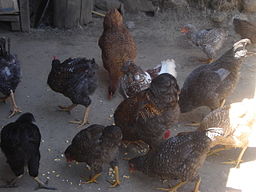Bird Flu Preparedness: H1N1 Avian Influenza N95 Masks and Silver Solution

With human resistance to viral infections falling, bird flu preparedness is a necessary aspect of survival training awareness. Avian influenza, also known as bird flu, is a naturally occurring virus found in all bird species.
While many wild birds carry the virus but do not become sick, domesticated birds such as turkeys, chickens and ducks can easily contract the virus and develop severe and often fatal intestinal and respiratory infections. Transmission of a highly pathogenic class of avian influenza via body secretions of infected birds can wipe out a large group of domesticated fowl within two days.
Human Infection
Now that we know how avian influenza is transmitted, effective implementation of bird-flu preparedness is a viable and necessary aspect of any survival plan. Because viruses quickly evolve to resist medications, humans cannot always rely on anti-viral solutions to prevent bird flu from becoming a pandemic. However, preventative tactics do exist to reduce the chance of contracting bird flu should a pandemic occur.
The first recorded instance of suspected bird flu occurred in late 1800 Italy, when chickens began dying of a strange disease. However, it was not until 1997 when eighteen people living in Hong Kong developed severe upper respiratory symptoms requiring hospitalization. Six of these individuals died because of contracting the H5N1 strain of bird flu. Six years later, two more people fell ill to bird flu, with one victim dying from the disease.
People suffering from bird flu exhibit symptoms resembling regular flu, aching muscles, fever, sore throat, coughing and nausea. However, bird flu viruses contain unique mutations differing from human flu viruses that correlate to how the virus replicates as well as to immune system suppression.
Due to these aberrations, bird flu seriously sickens people by producing severe respiratory complications that include pneumonia, breathing problems, conjunctivitis, and shock. No cure for bird flu currently exists other than treating symptoms as they appear.
Strategies for Bird Flu Preparedness
The best defense against illness is always prevention such as:
- Always cook poultry in temperatures higher than 70 degrees Fahrenheit. Average cooking temperatures will cause viral inactivation preventing transmission of the disease. As of today, no evidence exists indicating that eating meat contaminated with bird flu viruses will infect the person consuming it as long as it is well cooked.
- Do not handle cooked poultry after touching raw poultry unless you wash your hands between touching the meats.
- Never put cooked poultry on the same surface where uncooked poultry once sat.
- Refrain from using soft-boiled eggs in recipes that do not require cooking
- Plan for probable closings of restaurants, banks, post offices and even schools by keeping cash on hand. If you do not already home school your child, pick up home schooling supplies.
- Plan for overcrowding of hospitals and urgent care clinics by keeping well-stocked with medicinal supplies as well as plenty of hydrogen peroxide and chlorine bleach, two effective solutions that kill viruses.
- Other items vital to bird-flu preparedness include ibuprofen, anti-diarrheal medicine and laundry detergent to maintain cleanliness of bed linens, towels and clothes.
- During a bird flu pandemic, enough people may become ill to shut down electricity plants. To prepare for this type of disaster, keep generators handy and stock up on batteries, flashlights, candles, manual can openers and portable radios.
Personal Protective Equipment
When venturing outside during a bird flu pandemic, utilizing PPE is necessary to prevent possible infection. Special types of facemasks known as N95 respirators will halt transmission of the virus into your respiratory system.
N95 respirators are disposable and remain effective for eight hours, after which you will need to replace them. Wearing eye goggles, latex gloves and clothing impervious to secretions, rain gear, for example, are highly recommended as well.
Also, be aware that if a bird flu pandemic occurs, demand for PPE items will skyrocket, so stock up on them ahead of time to avoid infection. Bird flu preparedness means not waiting until bird flu is infecting half the world's population before attempting to purchase PPE.
Viral and bacterial pandemics can last months and even years before researches find a cure or the virus eventually evolves into a non-infectious form. Attending to bird flu preparedness now instead of later will keep you and your family alive and healthy during a worldwide bird flu pandemic.
Return from Bird Flu Preparedness to Survival Situations





New! Comments
Have your say about what you just read! Leave me a comment in the box below.